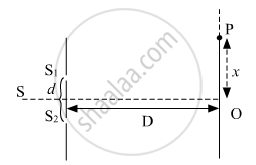Advertisements
Advertisements
प्रश्न
Monochromatic fight of wavelength 198 nm is incident on the surface of a metallic cathode whose work function is 2.5 eV How much potential difference must be applied between the cathode and the anode of a photocell to just stop the photocurrent from flowing?
उत्तर
λ = 198 nm = 198 × 10-9 m
W = 2.5 eV
∴ Energy of the incident photon
E = `"hc"/lambda = (6.6 xx 10^-34 xx 3 xx 10^8)/(198 xx 10^-9 xx 1.6 xx 10^-19) "eV"`
`= (6.6 xx3)/(198 xx 1.6) xx 100 = 6.25 "eV"`
∴ Energy of the ejected electron = 6.25 - 2.50 = 3.75 eV
∴ The retarding potential to stop the elctron = 3.75 V
APPEARS IN
संबंधित प्रश्न
Monochromatic light of frequency 6.0 × 1014 Hz is produced by a laser. The power emitted is 2.0 × 10−3 W. Estimate the number of photons emitted per second on an average by the source
When light travels from a rarer to a denser medium, the speed decreases. Does this decrease in speed imply a reduction in the energy carried by the wave?
A monochromatic ray of light falls on a regular prism. What is the relation between the angle of incidence and angle of emergence in the case of minimum deviation?
State the essential conditions for diffraction of light ?
When monochromatic light is incident on a surface separating two media, why does the refracted light have the same frequency as that of the incident light?
Which of the following sources provides the best monochromatic light?
Monochromatic light of wavelength 650 nm falls normally on a slit of width 1.3 x 10-4 cm and the resulting Fraunhofer diffraction is obtained on a screen. Find the angular width of the . central maxima.
Answer the following question.
In the diffraction due to a single slit experiment, the aperture of the slit is 3 mm. If monochromatic light of wavelength 620 nm is incident normally on the slit, calculate the separation between the first order minima and the 3rd order maxima on one side of the screen. The distance between the slit and the screen is 1.5 m.
(a) Can the interference pattern be produced by two independent monochromatic sources of light? Explain.
(b) The intensity at the central maximum (O) in Young's double-slit experimental set-up shown in the figure is IO. If the distance OP equals one-third of the fringe width of the pattern, show that the intensity at point P, would `"I"_°/4`

(c) In Young's double-slit experiment, the slits are separated by 0⋅5 mm and the screen is placed 1⋅0 m away from the slit. It is found that the 5th bright fringe is at a distance of 4⋅13 mm from the 2nd dark fringe. Find the wavelength of light used.
Monochromatic light of wavelength 396 nm is incident on the surface of a metal whose work function is 1.125 eV. Calculate:
- the energy of an incident photon in eV.
- the maximum kinetic energy of photoelectrons in eV.
